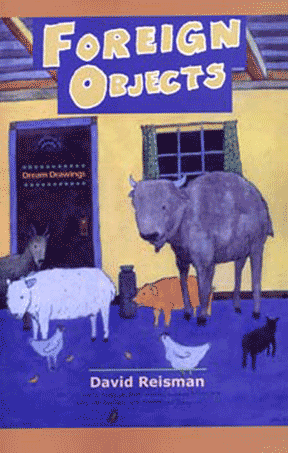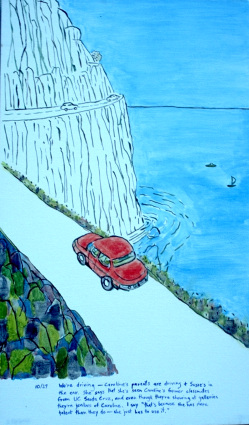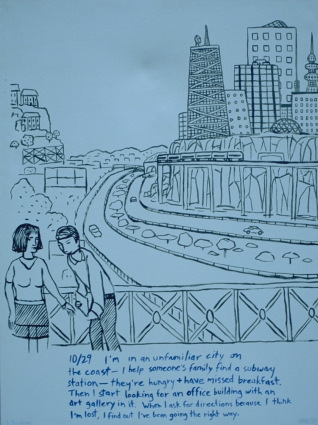|
[?]Subscribe To This Site
|
David ReismanDavid Reisman has a master’s of fine arts in painting from the UI and a doctorate in education from Columbia University, lives in New York City, where he is senior editor in the educational publishing department of 13/WNET Television. 
"Foreign Objects" focuses on journals from 1995 to 1996. In the journals, he would write down what he remembered from his dreams and then make drawings later. He undertook these drawings as "a kind of discipline," faithfully writing down whatever he could recall of his dreams each morning, then adding drawings later on. As an artist, he was interested in his dreams as a source of imagery uniquely his own. Moreover, they were a limitless source – perfect for maintaining a daily practice. During this period, he amassed over a thousand dream drawings, of which nearly two hundred are presented in Foreign Objects. 
10/29We're driving -- Caroline's parents are driving + Susie's inthe car. She says that she's seen Caroline's former classmatesfrom UC Santa Cruz, and even though they're showing in galleriesthey're jealous of Caroline. I say "that's because she has moretalent than they do -- she just has to use it." 
10/29I'm in an unfamiliar city onthe coast -- I help someone's family find a subway.station -- they're hungry + have missed breakfast.Then I start looking for an office building with anart gallery in it. When I ask directions because I thinkI'm lost, I find out that I've been going the right way.
Family and his life in New York are often topics of David’s dreams, but also appearing in them are a host of celebrities such as Bob Dylan, Bruce Springsteen, Francis Ford Coppola and George Burns. With the drawing of the late Burns comes the caption: “I see George Burns – he’s wearing glasses with two big diamonds in the lenses, like weird bifocals. I tell him I’m surprised to see him. He tells me it wasn’t his time to go.” Working on his dream drawings led David to make connections with some interesting people, including other artists doing dream-related work. One of them, Rick Veitch, wrote a blurb for David: “Reading ‘Foreign Objects’ is like visiting a Museum of Everyday Life that’s been broken down into its quantum state and reassembled as a surrealist masterpiece! David Reisman’s dream art is autobiography at its most auto-luminescent.” “While dreams are part of a private experience and dream drawings are somewhat self-indulgent,” he wrote for the preface of his book, “there’s an aspect of dream-based artwork that is potentially helpful in the same way that reading good fiction can feel liberating.” |
|


